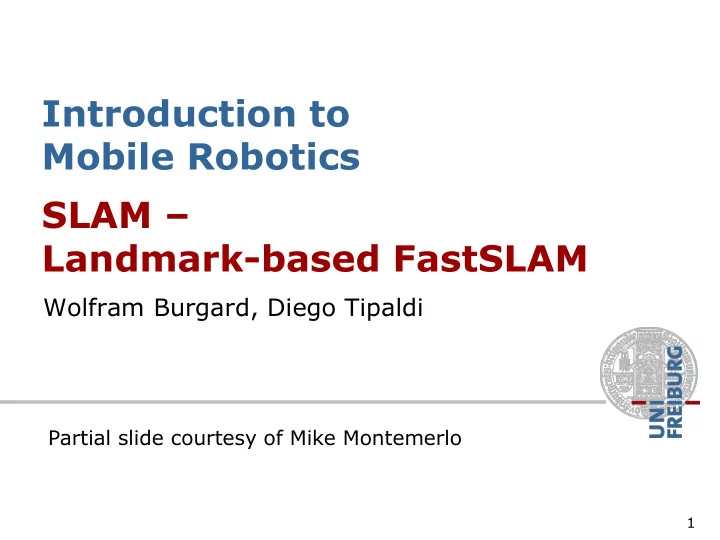

Introduction to Mobile Robotics SLAM – Landmark-based FastSLAM Wolfram Burgard, Diego Tipaldi Partial slide courtesy of Mike Montemerlo 1
The SLAM Problem SLAM stands for simultaneous localization and mapping The task of building a map while estimating the pose of the robot relative to this map Why is SLAM hard? Chicken-or-egg problem: A map is needed to localize the robot A pose estimate is needed to build a map 2
The SLAM Problem A robot moving though an unknown, static environment Given: The robot ’ s controls Observations of nearby features Estimate: Map of features Path of the robot 3
Map Representations Typical models are: today Feature maps Grid maps (occupancy or reflection probability maps) 4
Why is SLAM a Hard Problem? SLAM : robot path and map are both unknown! Robot path error correlates errors in the map 5
Why is SLAM a Hard Problem? Robot pose uncertainty In the real world, the mapping between observations and landmarks is unknown Picking wrong data associations can have catastrophic consequences Pose error correlates data associations 6
Data Association Problem A data association is an assignment of observations to landmarks In general there are more than (n observations, m landmarks) possible associations Also called “ assignment problem ” 7
Particle Filters Represent belief by random samples Estimation of non-Gaussian, nonlinear processes Sampling Importance Resampling (SIR) principle Draw the new generation of particles Assign an importance weight to each particle Resample Typical application scenarios are tracking, localization, … 8
Localization vs. SLAM A particle filter can be used to solve both problems Localization: state space < x, y, > SLAM: state space < x, y, , map> for landmark maps = < l1, l2, …, lm> for grid maps = < c11, c12, …, c1n, c21, …, cnm> Problem: The number of particles needed to represent a posterior grows exponentially with the dimension of the state space! 9
Dependencies Is there a dependency between certain dimensions of the state space? If so, can we use the dependency to solve the problem more efficiently? 10
Dependencies Is there a dependency between certain dimensions of the state space? If so, can we use the dependency to solve the problem more efficiently? In the SLAM context The map depends on the poses of the robot. We know how to build a map given the position of the sensor is known. 11
Factored Posterior (Landmarks) poses map observations & movements Factorization first introduced by Murphy in 1999 12
Factored Posterior (Landmarks) poses map observations & movements SLAM posterior Robot path posterior landmark positions Does this help to solve the problem? Factorization first introduced by Murphy in 1999 13
Rao-Blackwellization Factorization to exploit dependencies between variables: If can be computed in closed form, represent only with samples and compute for every sample It comes from the Rao-Blackwell theorem
Revisit the Graphical Model Courtesy: Thrun, Burgard, Fox
Revisit the Graphical Model known Courtesy: Thrun, Burgard, Fox
Landmarks are Conditionally Independent Given the Poses Landmark variables are all disconnected (i.e. independent) given the robot’s path
Factored Posterior Robot path posterior Conditionally (localization problem) independent landmark positions 21
Rao-Blackwellization for SLAM Given that the second term can be computed efficiently, particle filtering becomes possible! 22
FastSLAM Rao-Blackwellized particle filtering based on landmarks [Montemerlo et al., 2002] Each landmark is represented by a 2x2 Extended Kalman Filter (EKF) Each particle therefore has to maintain M EKFs Particle x, y, … Landmark 1 Landmark 2 Landmark M #1 Particle x, y, … Landmark 1 Landmark 2 Landmark M #2 … Particle x, y, … Landmark 1 Landmark 2 Landmark M N 23
FastSLAM – Action Update Landmark #1 Filter Particle #1 Landmark #2 Filter Particle #2 Particle #3 24
FastSLAM – Sensor Update Landmark #1 Filter Particle #1 Landmark #2 Filter Particle #2 Particle #3 25
FastSLAM – Sensor Update Particle #1 Weight = 0.8 Particle #2 Weight = 0.4 Weight = 0.1 Particle #3 26
FastSLAM – Sensor Update Update map Particle #1 of particle #1 Update map Particle #2 of particle #2 Update map Particle #3 of particle #3 27
FastSLAM - Video 28
FastSLAM Complexity – Naive Update robot particles O(N) based on the control Incorporate an observation O(N) into the Kalman filters Resample particle set O(N M) N = Number of particles M = Number of map features
A Better Data Structure for FastSLAM Courtesy: M. Montemerlo
A Better Data Structure for FastSLAM
FastSLAM Complexity Update robot particles based on the control Incorporate an observation into the Kalman filters O(N log(M)) Resample particle set N = Number of particles O(N log(M)) M = Number of map features
Data Association Problem Which observation belongs to which landmark? A robust SLAM solution must consider possible data associations Potential data associations depend also on the pose of the robot 33
Multi-Hypothesis Data Association Data association is done on a per-particle basis Robot pose error is factored out of data association decisions 34
Per-Particle Data Association Was the observation generated by the red or the brown landmark? P(observation|brown) = 0.7 P(observation|red) = 0.3 Two options for per-particle data association Pick the most probable match Pick an random association weighted by the observation likelihoods If the probability is too low, generate a new landmark 35
Results – Victoria Park 4 km traverse < 5 m RMS position error 100 particles Blue = GPS Yellow = FastSLAM 36 Dataset courtesy of University of Sydney
Results – Victoria Park (Video) 37 Dataset courtesy of University of Sydney
Results – Data Association 38
FastSLAM Summary FastSLAM factors the SLAM posterior into low-dimensional estimation problems Scales to problems with over 1 million features FastSLAM factors robot pose uncertainty out of the data association problem Robust to significant ambiguity in data association Allows data association decisions to be delayed until unambiguous evidence is collected Advantages compared to the classical EKF approach (especially with non-linearities) Complexity of O(N log M) 39
Recommend
More recommend